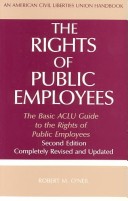An American Civil Liberties Union handbook
1 total work
In this revised and updated edition of "The Rights of Public Employees, "Robert M. O Neil broadens the focus from government employees to all public employees, emphasizing the public-service nature of the occupations and professions of such individuals. Using a question-and-answer format, O Neil covers such topics as public employment and individual rights; initial qualifications of public employees; public employment and freedom of speech; politics, patronage, public service, and unions; the private lives of public employees; discrimination based on race, gender, and disability; and the procedural rights of public employees.
In the decade and a half between editions, some themes have remained constant: few changes have occurred in the areas of loyalty oaths, political and religious testing, public employees political involvement, and freedom of speech involving matters of general importance. This edition, however, does reflect substantial changes in the law of public employment.
Dramatic changes have taken place, for example, in the development of drug and AIDS testing in the workplace. Employers are demanding more information than they did in the 1970s citizenship, age, height, weight, and criminal record are determined before making a hire. These and other important changes that have occurred in the area of physical privacy and race and gender discrimination have prompted Congress and the courts to call for a significant reexamination of current policy. Similarly, mandatory retirement and the issue of procedural rights of public employees have recently received close scrutiny from lawmakers and judges.
O Neil emphasizes constitutional as well as statutory rights of people who work for the government. The rights of public employees are steadily expanding and being refined. At the same time, important differences remain (and probably will always remain) between the public and private sectors.
In defining the rights of public employees in the United States, O Neil explains in detail the changes in policies and procedures that have taken place in recent years and that, in some cases, are currently under examination. With this valuable guide, public employees can gain a better understanding of their rights and thus be more confident in exercising those rights."
